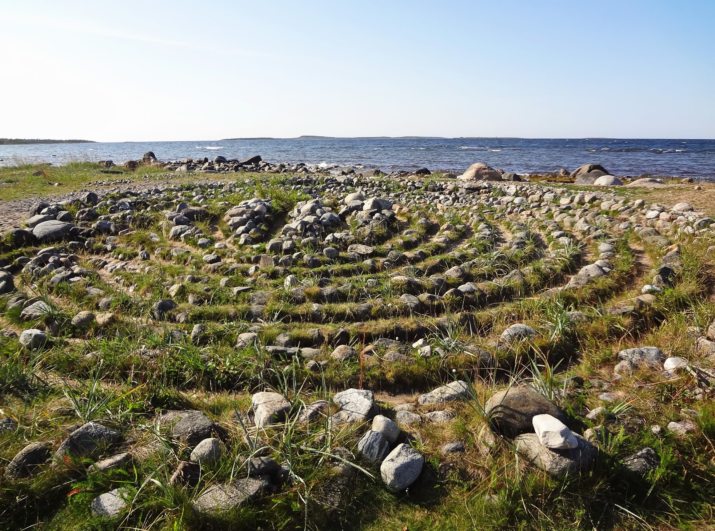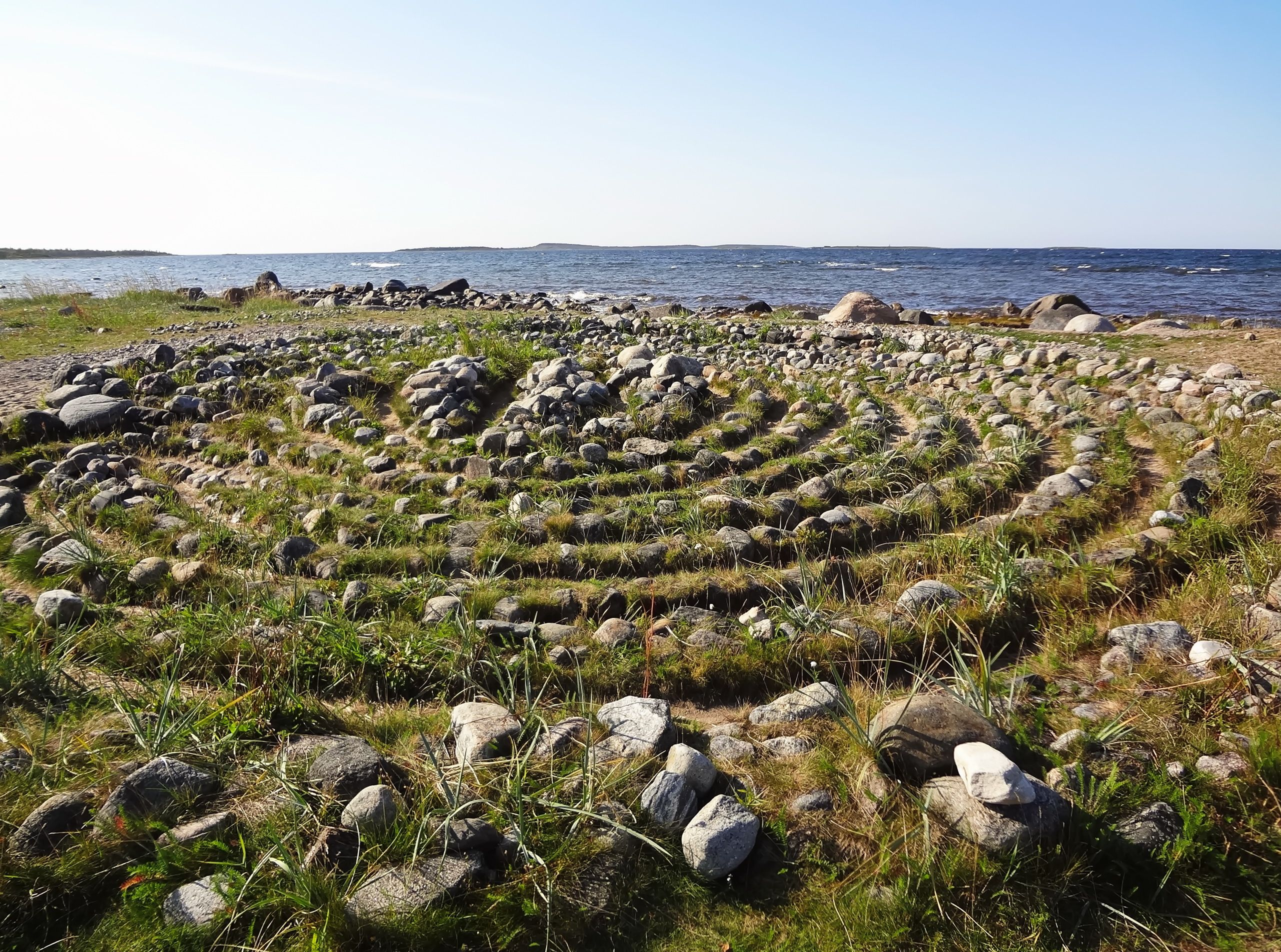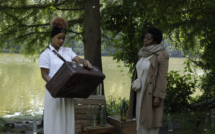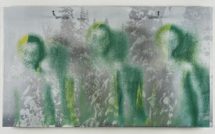

This is part of our special feature, Decolonizing European Memory Cultures.
On May 16, 2022, Swedish and Finnish ambassadors met to discuss the possibility of joining NATO in international solidarity against Russian aggression in Ukraine. Maps appeared in the international press showing the proposed new “Russo-Finnish” NATO border. However, the coastal regions of the White Sea and Gulf of Bothnia are not exclusively European territory; they are home to the Saami.[1] Saamiland has preceded the modern Finnish and Russian occupation of the region; indeed, Saami coastal settlements were expropriated by premodern Europeans, who also eradicated the ways in which the Saami cultivated ecosystems, their religious practices, and their crafts—particularly their metalwork. A microcosmic history of Solovki in the White Sea provides a new interpretation of the region and provides an Indigenous rather than hegemonic history of the Russo-Finnish circumpolar territory. In the contemporary context, this approach offers a more nuanced understanding of circumpolar environmental racism and of the ways in which such imposed borders have materially affected Indigenous peoples.
The history of the Solovetsky Islands (Solovki), a polar archipelago in the White Sea, has been mythologized and narrated almost to the point of abstraction. Accounts of the islands have focused on pre-Soviet Russian Orthodoxy and the establishment of monasteries there, while Soviet histories have emphasized the GULAG detention system, which came to occupy the very same monastic complexes in the 1920s and 1930s. These paradigms feature a Russo-centric understanding of the territory as an occupied and penal space. Differing epistemologies and different approaches to the documenting of circumpolar peoples have been entirely excluded from this Russo-centric perspective; indeed, the islands were not founded nor discovered with the Orthodox colonization of the 1400s or with the Soviet imposition of the GULAG. Russia, and later the Soviet Union, operated on imperial and colonial frames of statecraft.[2] Russia treated indigeneity in a primitivist way to bolster its own claims to legitimacy and power; this reflexive strategy served as a mirror revealing Russia’s own distinct style of colonialism, which differed from that of other European empires.[3]
Imposed labyrinths and monasteries on Solovki
The nomadic Saami arrived at the White Sea coast in roughly the year 1000 CE.[4] The Saami were originally from an area near the Ural Mountains, as evidenced by markers in their language, but climate warming and crop failure from 1100 to 1350 forced them to migrate around the polar region, at the same time as when Nordic power was consolidated through compulsory Christianity.[5] On Solovki, three orthodox ascetics arrived in the 1400s—Savvati, Herman, and Zosima—and built the monastic complexes that stand to this day.[6] Spiritually, the shamanistic beliefs of the Saami were widely appropriated by Christianity, most notably with the construction of Christian sites on Saami sites of sacrifice and bear rituals.[7] Saami religious practices entail nine essential traits that are applicable to all sects across time:
- An animated nature personified by gods;
- Reindeer herding and cultivation practices represented by specific guardians;
- Power and danger associated with specific locales;
- Gods worshipped in the form of unusual stones, cliffs, or wooden idols;
- Cults and rituals with utilitarian motives such as herding;
- Absence of priesthood; use of drums for the spiritual needs of each family;
- Drums as primary instruments;
- Bears as part of the most distinctive of Saami practices; and
- Many specific female taboos at ritual sites.[8]
If we accept these Saami religious principles and the fact that the archipelago was not in fact uninhabited when the monastic Orthodox order arrived in the region, we may wonder how the Saami were Christianized on Solovki. The most evident type of colonization was spatial: monasteries were quite literally constructed on top of areas that were sacred to the Saami. Labyrinths on the islands had been constructed by the Saami on top of circular bear burial sites or on the foundations of circular homes. The labyrinth was a Saami symbol of death and dangerous journeys, a trepidatious path through life itself. Christians built their own labyrinths to ward off environmental dangers and heathenism. The proximity of these Christian labyrinths to circular sacrificial sites in the White Sea region indicates the Christianization of Saami practices.[9] Sacred sites in which power was concentrated, such as lakes, points and peninsulas, capes, and caves were also sites on which churches were constructed in the 1400s on Solovki.[10] Christian descriptions condemned Saami practices as heathen, in particular healing practices that were seen as primitive; Christians saw the Saami as simple people who lived in harmony with nature and with the world.[11] As of 2006, there were only 1600 Saami people left anywhere in Russia, and many of the Slavic languages they spoke had been completely eradicated.[12] By calling the island uninhabited, the thaumaturgist colonizers—magic-working Christians—in Solovki predicted the Saami people’s epistemic eradication and absorption. The churches and monasteries remaining today stand on Saami sacred ground, and the Saami labyrinths outside Christian sites connect the Christian and Indigenous worlds of the dead.
The GULAG
The most famous account of the GULAG[13] in Western consciousness is Aleksandr Solzhenitsyn’s Gulag Archipelago, in which he connected the literal archipelago of Solovki—the first GULAG—thematically and linguistically to the network of remote camps across the USSR.[14] The Soviet detention strategy followed imperial models, i.e., it entailed exporting undesirable and dangerous people to, again, “uninhabited” Siberian remote locales.[15] However, throughout the seventy-year history of the GULAG, Indigenous communities were intentionally used to support the detention system. The Soviet detention system used local knowledge about the environmentally foreboding north and ways to extract natural resources. Indeed, the prisons relied on local and Indigenous knowledge for their existence and to effectively utilize labor. Furthermore, the establishment of the camps’ physical structures destroyed local environments, for example through the extraction of local resources, which were shipped back to Moscow and St. Petersburg. The camps extracted knowledge and resources and also made a spiritual incursion into Indigenous communities by poorly addressing the burial of those prisoners who died a violent death.[16]
The GULAG on Solovki was operational from 1923 to 1933; it entailed a functional hub and a prison that was located in the former monastery buildings and different sites of forced daily labor around the islands; its peak population reached 71,800 interned people; moreover, 7,500 died there.[17] The Solovki camp was an early attempt by the Soviets to make detention profitable and constituted an attempt at appropriating Christian and preexisting structures to use them as spaces of detention and violence. The prisoner barracks and administration office were established in the recently closed and repurposed Solovetsky Monastery, which had been built in close proximity to Saami sacred sites where bear burials had been repurposed by the Christians as labyrinths.[18] In the tiny space of roughly 13 square km, prisoners were sent to die on two hills. One of these hills, Sekirka, had been a sacred site of sacrifice for the Saami and a site of pilgrimage and reflection for monks. However, it became a site for brutal executions in the GULAG system, as half-dead Russian prisoners were strapped to logs and pushed down the 365 steps of Sekirka’s now infamous staircase.[19]
Christian colonization eradicated the Saami on Solovki and forced them to Kola and Finland while appropriating their sites and practices. In the 1920s, Sovietization replaced Christianity, and the Soviet edifice of the GULAG was built on those Christian sites that had also been Saami sites. Neither Christians nor Soviets had a claim to Solovki and the brutality of the GULAG replaced the brutality of Christian colonization. Sites of violence such as Sekirka staircase, scars of mining and environmental destruction, and the buildings of the monastery-turned-prison are physical reminders of an unwelcome and foreign incursion into Saami space. Today, the stone used in Moscow to commemorate the GULAG was taken from Solovki; it is indeed a flat stone, similar to those found on the coast and that would have been integral to bear rituals in pre-Soviet Saami culture.[20] Even in those scarce accounts of the GULAG, there has been no acknowledgement of the ways in which the prison has affected indigenous communities and led to the intentional subjugation of communities and “elimination of the natives”—to borrow from Patrick Wolfe’s writing on settler colonialism—beyond its walls.
Radioactivity in Kola
The environmental degradation of Saamiland did not end when the Soviet Union collapsed in 1991. A 1998 Swedish study covering the years from 1996 to 1998, the earliest years of the Putin administration in Russia, revealed the presence of unstable nuclear materials in the Kola Peninsula—the site where the Saami have settled since 1900, just north of the Solovki Archipelago. That study specifically mentioned the radioactivity levels due to the 1989 sinking of a nuclear submarine near Bear Island. The study also mentioned weapons testing on Novaya Zemlya—a larger peninsular archipelago in the Barents sea—and the contamination of the Ob River in Siberia.[21] The study established that environmental and biological transfers mainly occurred via reindeer, a vital part of the food chain for certain populations such as the Saami.[22] The perception of risk was also noted at the end of the study, as it was highlighted that “certain populations” need to be aware of these radioactive concerns since they come into contact in various ways with that environment.[23] The study indicated that radioactivity is a substantial and continuing concern in Kola. Some of the language used in the study highlighted the specific effects of this radioactive presence on the Saami without naming them explicitly as an ethnic group, for example though the mention of the impacts on herding and the biological detriment to reindeer pastoralism. The study also mentioned the fact that radiation is present in close proximity to Bear Island, on which an ancient site is located, and acknowledged the pollution of rivers. Although death caused by radioactivity is unseen, it is nonetheless pervasive in the region, as this radioactivity has polluted the land and environmentally targeted circumpolar communities that had already been affected by Christianization and the use of the area as a place of detention.
Unfortunately, environmental racism in Saamiland has persisted into the current political reality. In a 2006 report, interviewed Saami reported fatalistically on the resilience of their culture in the wake of the widespread eradication of their herding practices, substantial unemployment, and increasing reliance on alcohol.[24] The “invisible borders” between Russia, Finland, and Sweden were mentioned as in fact significant, along with the corresponding impositions and effects on indigenous practices. A litany of instances of environmental destruction was raised in those interviews, from coal mining to isotopic radiation to gas transport and pipelines crossing the Saami territory. That territory is rich in natural resources. For example, a gold mine was exploited on reindeer herding territory starting in 1998 and protests in 2013 and 2022 erupted about other ore mines.[25] Both ore mining and radioactive contamination are highly destructive; in 2014, the facilities associated with a nickel extraction mine on the Kola Peninsula showed pollution levels in excess of nearly seven times the allowed ratio.[26] As new herding practices and available natural resources have forced 100,000 Saami to move into different areas around the White Sea and Gulf of Bothnia, modern environmental problems are no longer exclusively caused by Russia. In fact, the European borders that were artificially drawn across indigenous land have also affected the allocation of the rich natural resources in the region, and the environmental effects have been catastrophic.
In 2019, in the White Sea area, abandoned barges and weapons testing caused radioactive contamination to move from the Kola region to Arkhangelsk, passing through Solovki. This radioactive pollution has remained concealed from the local residents, ambiguously described in the foreign press and denied in the Russian realpolitik agenda.[27] This situation has persisted, as the Kola Peninsula has been receiving radioactive waste from southern Russia that is brought to the island for storage and decontamination. These activities have set a dangerous precedent for Kola to continue constituting an isolated dumping site, although it is costly for Russia to dispose of its waste there.[28] However, the transfer of these materials to “uninhabited” Kola willfully misreads the circumpolar north. In fact, Kola and the surrounding White Sea area are not uninhabited. Like the reading of the Christian missionaries who arrived in “abandoned” Solovki, the reading of the White Sea coast as uninhabited and abandoned allows an understanding of that space as colonized, penalized, and irradiated in disregard for the Saami populations that preexisted on that land.
Saamiland today
As new borders have been established through the circumpolar north and Russia has become increasingly antagonistic on the geopolitical stage, the legacy of the entire region should be considered from a non-hegemonic and non-European perspective. This region and its inhabitants have existed in these spaces for generations and continue to do so. They have inherited these spaces and should not be considered Indigenous obstacles to accessing the valuable natural resources that are present on that land. The circumpolar region is generally not discussed as part of a “world system” in which resources are exported from a periphery to a core.[29] In the Russian context, while the periphery does provide natural resources to the core, the core sends radioactive toxicity and criminality to the periphery. The region has suffered at the hands of supporters of the imperial power, has been used as a place to relocate prisoners who were to be reeducated and Sovietized, and has been used as a site for radioactive dumping. The fact that the Russians exported spiritual and physical toxicity from Russia to the White Sea region has revealed their attitude toward Indigenous communities and highlighted environmental racism and the deliberate genocidal eradication of material practices such as herding. The Russian disregard for sacred sites, practices, language, and peoples is part of a historical continuum involving the Russian Empire, the Soviet Union, and present policies in Saamiland.
Alexandra Birch is a professional violinist and scholar of music and mass atrocity in the former USSR. She is currently a PhD student in history at UC Santa Barbara.
References
[1] In anthropological writing, the preferred transliteration is Saami rather than Sámi, favoring an orthography toward an approximation of Saami language and away from Norwegian. Robert Paine, Herds of the Tundra: A Portrait of Saami Reindeer Pastoralism (Washington DC: Smithsonian Institution Press, 1994), xi.
[2] Ronald Grigor Suny, “The Empire Strikes Out: Imperial Russia, “National” Identity, and Theories of Empire,” in A State of Nations: Empire and Nation-making in the Age of Lenin and Stalin (Oxford: Oxford University Press, 2001).
[3] Yuri Slezkine, Arctic Mirrors: Russia and the Small Peoples of the North (Ithaca: Cornell University Press, 1994).
[4] For ease, I refer to dates in the accepted Western system of CE and BCE. However, I have excluded structural markers of time like “Medieval, Bronze Age” etc. in favor of a decolonized history separate from European markers.
[5] Noel D. Broadbent. Lapps and Labyrinths: Sami Prehistory, Colonization, and Cultural Resistance (Washington DC: Smithsonian Institution Scholarly Press, 2010), 15 on language, 149, 162.
[6] See this Russian website that suggests books on individual saints, and a comprehensive discussion of Christianity on Solovki : https://www.solovki.ca/saints_11/11_60.php#.
[7] Broadbent, Lapps and Labyrinths, 214.
[8] Ernst Manker, Lapparnas heliga ställen: kultplaster och offerkult I belysning av Nordiska museets och landsantikvariernas fätundersökningar, Vol. 13, Geber, 1957, 10-11. .
[9] Broadbent, Lapps and Labyrinths, 184, 211-14.
[10] Ibid., 173. These sites and labyrinths are visible on GIS data including Google.
[11] Stein R. Mathisen, “Constituting Scholarly Versions of a Sámi Folk Medicine Research Practices in the Colonial Contact Zone,” in Idioms of Sámi Health and Healing, (Edmonton, Alberta: University of Alberta Press, 2015), 2.
[12] Jorn Madslien, “Russia’s Sami fight for their lives,” BBC News (Lovozero, Russia), December 21, 2006, Accessed June 3, 2022, http://news.bbc.co.uk/2/hi/business/6171701.stm.
[13] GULAG: Glavnoye Upravlyenii Lagerei – or the state administration of camps appears in all capitals as an acronym from the Russian GULag.
[14] GULAG is an acronym for Glavnoye Upravleniye Lagerie or “Chief Administration of Camps” typically applied to the entire Soviet system of detention.
[15] Sarah Badcock, A Prison Without Walls?: Eastern Siberian exile in the last years of Tsarism (Oxford: Oxford University Press, 2016).
[16] Marjorie Mandelstam Balzer, “Local legacies of the GULag in Siberia: Anthropological reflections,” Focaal 2015, no. 73 (2015): 99-113. And on the Eveny and Eastern Siberia: Olga Ulturgasheva, “Ghosts of the Gulag in the Eveny World of the Dead,” The Polar Journal 7, no. 1 (2017): 26-45. And: Alexandra Noi, “The Ex-prisoners of the Gulag in the modern Siberian Expeditions,” in Invisible Labour in Modern Science (Rowman and Littlefield Publishers, 2022), p. 81-88.
[17] M.B. Smirnov, Sistema ispravitel’no-trudovykh lagerei v SSSR, 1923-1960 (Moscow: Zven’ya, 1998).
[18] Roy R. Robson, Solovki The Story of Russia Told Through its Most Remarkable Islands (New Haven: Yale University Press, 2004) 215.
[19] Robson, Solovki, 226-228.
[20] Marina Obrazkova, “Victims of Stalinist Repressions Remembered at Moscow Ceremony,” Russia Beyond the Headlines, October 30, 2014, Accessed June 10, 2022, http://rbth.com/society/2014/10/30/victims_of_stalinist_reepressions_remembered_at_moscow_ceremony_4.
[21] Ronny Bergman and Alexander Baklanov, Radioactive sources of main radiological concern in the Kola-Barents region (Stockholm, Sweden: FRN, 1996).
[22] Bergman and Baklanov, Radioactive Sources, 16.
[23] Ibid, 70.
[24] Madslien, “Russia’s Sami fight for their lives,” http://news.bbc.co.uk/2/hi/business/6171701.stm.
[25] Ibid., and Liz-Marie Nilsen, “Sámi protest against British mining company,” Survival International News (Online, Berlin, Madrid, Paris, London, San Francisco), September 3, 2013, Accessed June 3, 2022, https://www.survivalinternational.org/news/9529. And Euractiv, “Thunberg protests against Sweden iron ore mine on Sámi land,” Euractiv.com AFP (Online, Brussels), February 6, 2022, Accessed June 3rd, 2022, https://www.euractiv.com/section/energy-environment/news/thunberg-protests-against-sweden-iron-mine-on-sami-land/.
[26] Charles Digges, “Kola Peninsula nickel production facilities issues itself license to continue to pollute, continuing month of grave air code violations,” Bellona (Oslo, Norway), June 2, 2014, Accessed May 20, 2022, https://bellona.org/news/industrial-pollution/2014-06-kola-peninsula-nickel-production-facilities-issues-license-continue-pollute.
[27] Mike Eckel, “U.S. Concludes White Sea Radiation Explosion Came During Russian Nuclear-Missile Recovery,” Radio Free Europe (Prague, Czech Republic), October 12th, 2019, Accessed May 25, 2022, https://www.rferl.org/a/u-s-concludes-white-sea-radiation-explosion-came-during-russian-nuclear-missile-recovery/30213494.html#:~:text=A%20State%20Department%20official%20says,apparently%20crashed%20during%20a%20test.
[28] Thomas Nilsen, “Kola Peninsula to get radioactive waste from Southern Russia,” The Barents Observer (Kirkenes, Norway), May 31, 2021, Accessed June 1t, 2022, https://thebarentsobserver.com/en/nuclear-safety/2021/05/kola-peninsula-get-radioactive-waste-southern-russia.
[29] Broadbent, Lapps and Labyrinths, 24-25.
Published on February 21, 2023.




